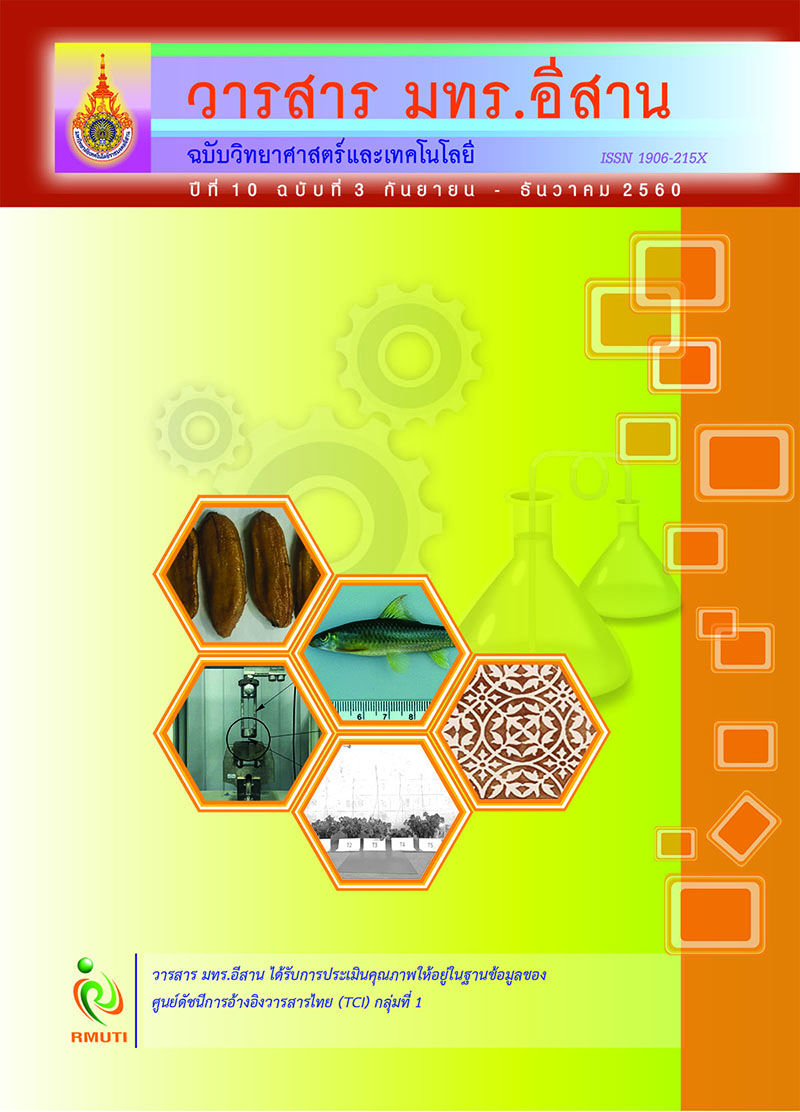ผลการใช้เทคนิค QFD ในการออกแบบและพัฒนาเว็บเชิงความหมายองค์ความรู้ข้าวไทย The Results of using the QFD Technique on Design and Develop the Semantic Web of Thai Rice Ontology
Main Article Content
Abstract
บทคัดย่อ
การวิจัยครั้งนี้แสดงการประยุกต์ใช้เทคนิคการกระจายหน้าที่เชิงคุณภาพ (QFD) เพื่อค้นหาคุณลักษณะของระบบที่ผู้ใช้ต้องการแล้วนำมาออกแบบและพัฒนาเว็บเชิงความหมายองค์ความรู้ข้าวไทย เพื่อนำเสนอและสืบค้นข้อมูลองค์ความรู้ขาวไทยจากออนโทโลยี การดำเนินงานเริ่มจากการรวบรวมความต้องการของผู้ใช้งานนำมาสร้างแบบสอบถามเพื่อหาลำดับความสำคัญในแต่ละความต้องการ แล้วนำไปวิเคราะห์ด้วยเทคนิค QFD จากนั้นนำผลที่ได้ไปใช้ในการออกแบบและพัฒนาเว็บเชิงความหมาย ในการพัฒนาเว็บเชิงความหมายนี้ใช้ฐานข้อมูล MySQL และใช้ Jena API ในการเชื่อมต่อเพื่อใช้งานออนโทโลยี ผลการวิจัยแสดงผลลัพธ์ที่ได้จากการวิเคราะห์ด้วย QFD ซึ่งเป็นคุณลักษณะของระบบ พิจารณาจากค่าน้ำหนักความสำคัญ 5 ด้าน คือ 1) ด้านความสามารถในการทำงานตรงตามความต้องการ ให้ความสำคัญมากที่สุดกับความสามารถในการทำงานเฉพาะด้านมีค่าเฉลี่ย 3.81 2) ด้านหน้าที่ของระบบให้ความสำคัญมากที่สุดกับหน้าที่ของระบบในการนำข้อมูลเข้ามีค่าเฉลี่ย 4.16 3) ด้านการใช้งานระบบ ให้ความสำคัญมากที่สุดในเรื่องความง่ายต่อการเรียนรู้มีค่าเฉลี่ย 4.84 4) ด้านความปลอดภัยของระบบให้ความสำคัญมากที่สุดกับความปลอดภัยในการเข้าถึงข้อมูลมีค่าเฉลี่ย 2.47 และ 5) ด้านประสิทธิภาพ ให้ความสำคัญกับประสิทธิภาพและประสิทธิผลมีค่าเฉลี่ย 3.38 หลังจากนำคุณลักษณะของระบบมาออกแบบและพัฒนาเว็บเชิงความหมายองค์ความรู้ข้าวไทยพบว่าผลการประเมินประสิทธิภาพของระบบ (4.02) และความพึงพอใจของผู้ใช้งาน (4.17) โดยรวมทั้งหมดอยู่ในระดับมาก
Abstract
This research introduces the application of Quality Function Deployment (QFD) to determine the specifications of a system for design and develop the semantic web about
the Thai rice ontology. The research began with collecting the user requirements which were used in a questionnaire survey to identify the importance by analysis with
QFD technique. The results were used to design and develop a semantic web. The web development will enhance creating database by using MySQL and use Jena API to
connect ontology to the database. The results of this research found that consequence from QFD technique that there were five characteristics of specifications as follows;
1) a functional requirement, where the most relative importance was the capacity of specification functions (3.81); 2) a functionality, where the most relative importance was
the capacity of input function (4.16); 3) a usability, where the most relative importance was the capacity to learn (4.84); 4) a security, where the most important specification
was data accessing (2.47); 5) an efficiency, where the most important specification was efficiency and effectiveness (3.38). When the specifications were transformed to the
design and development, the overall system performance was high level (4.02) and user’s satisfaction was high level (4.17)
Article Details
References
[2] Rice Department. (2009). Thai Rice Certification Database. Access (25 April 2017). Available (https://www.brrd.in.th/rvdb/)
[3] Pathumthanee Rice Research Center. (2010). Genetic Database of Rice. Access (25 April 2017). Available (https://ptt-rrc.ricethailand.go.th)
[4] Kasetsart University. (2010). Thai Native Rice Database. Access (25 April 2017). Available (https://www.corsat.agr.ku.ac.th/doc/rdb/web_database/index.html)
[5] Agricultural Research Development Agency. (2017). Rice Research Database. Access (25 April 2017). Available (https://kasetinfo.arda.or.th/arda/rice)
[6] Kulnavin, K., Wongkalasin, T. and Yatigon, N. (2013). Ontology Design of Thai Rice. Nakhon Ratchasima : Nakhon Ratchasima Rajabhat University (in Thai)
[7] Prakittikornchai, S. (2007). Thai Herb Ontology Prototyping. M.Sc. Computer Science of King Mongkut’s University of Technology North Bangkok (in Thai)
[8] Suwanta, D. (2015). Ontology. Access (22 April 2017). Available (https://darawan.awardspace.info/powerpoint/ontology.pdf)
[9] Levesque, G. and Zamor, M. (2000). Requirements Management: From Technical to Managerial Aspects. In Proceedings of the International Conference Software & Systems Engineering and their Applications ICSSEA 2000. Paris : France. pp. 1-12
[10] Kulnawin, K., Longpradit, P., Charoenporn, C. and Bhattarakosol, P. (2014). Application of QFD Technique for Determining Specifications and Design of a Prototype System for Crop Yield Prediction. The Journal of King Mongkut’s University of Technology North Bangkok. Vol. 24. No. 3. pp. 512-525 (in Thai)
[11] Sasananan, M. (2007). Product Design and Reverse Engineering for Innovation. Bangkok : Thammasat Printing House (in Thai)
[12] Punroob, N. (2013). Development of Software Requirement Analysis System Based on ISO9126 using QFD Technique. M.Eng. Computer Engineering of Chiang Mai University (in Thai)
[13] Bualerng, S. and Songpan, W. (2014). Question Classification for Answer Searching Using Semantic Web and Data Mining. In Proceedings of the Tenth National Conference on Computing and Information Technology (NCCIT2014). KMITNB: Bangkok. pp. 101-108 (in Thai)
[14] Niwattanakul, S. (2015). Access to Agricultural Knowledge by Semantic Web Technologies. Nakhon Ratchasima : Suranaree University of Technology (in Thai)
[15] Apache Jena. (2017). Jena Ontology API. Access (25 April 2017). Available (https://jena.apache. org/documentation/ontology)
[16] Intarapadung, A. (2013). The Development of Prototype Program of QFD Tool to Transform Customers’ Needs into Product Design Automatically for SME Ceramic
Industry. The Journal of KMUTNB. Vol. 23. No. 2. pp. 378-389 (in Thai)
[17] Phanthumchinda, N. (2008). Development of Software for the Theory of Inventive Problem Solving. M.Eng.IE of Chulalongkorn University (in Thai)
[18] Butte, P. and Puarungroj, W. (2016). Development of Semantic Web for Searching Cultural Information in Loei Province. Information Technology Journal. Vol. 12. No. 2. pp. 33-41 (in Thai)
[19] Meemongkol, N. Junsong, P. and Santiamorntut, W. (2012). Application of Quality Function Deployment Technique for Searching of Device Characteristic and Design of Health Care Monitoring Device. KKU Research Journal. Vol. 17. No. 4. pp. 515-527 (in Thai)
[20] Thammabut, S. and Sodanil, M. (2013). Search System Siamese fighting fish with Ontology. In Proceedings of the Eighth National Conference on Computing and Information Technology (NCCIT2012). KMITNB : Bangkok. pp. 660-666 (in Thai)


